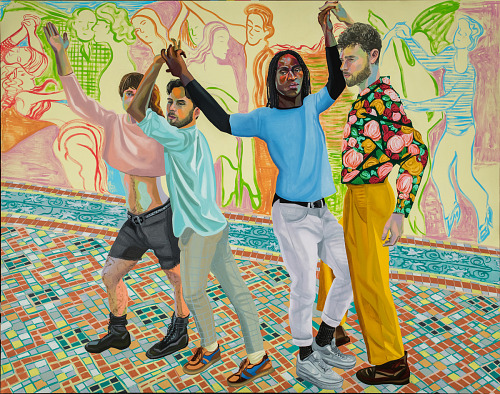
Aliza Nisenbaum
b. Mexico City, Mexico, 1977
Mis Cuatro Gracias (Brendan, Camilo, Carlos, Jorge)
2018
Oil on canvas
Joseph H. Hirshhorn Purchase Fund, 2021 (2021.016)
About Museums Without Men
Celebrated art historian Katy Hessel has launched an audio guide series highlighting the women and gender-nonconforming artists in the public collections of international museums. Museums Without Men is an ever-growing series that introduces museum visitors to underrepresented and often lesser-known artists, opening up collections to new and existing audiences who will be able to follow the audio stops while in the galleries or online. The series links public institutions globally, including the Fine Arts Museums of San Francisco; the Metropolitan Museum of Art, New York; the Hepworth Wakefield, UK; the Hirshhorn Museum and Sculpture Garden, Washington, DC; and Tate Britain, London, to foreground the important work that museums and galleries do by collecting and displaying women and gender-nonconforming artists, whether historical or contemporary.
Transcript
[00:00:00] Aliza Nisenbaum, Mis cuatro gracias (Brendan, Camilo, Carlos, Jorge) (2018). Four dancers, four friends, four graces, as the title Mis cuatro gracias suggests. This painting by Aliza Nisenbaum shows four figures united by their hands, caught in the midst of a dance, set against a kaleidoscopic backdrop with a tiled floor evocative of a museum in Berlin and a mural that features in a downtown New York salsa club.
For me, this picture exudes music, energy, and joy. Mexican born artist Nisenbaum is now based in New York City. She began her career as an abstract painter and found her route into figuration while working at an organization that supported immigrants in New York. Nisenbaum is a [00:01:00] painter who portrays a whole range of people in her community, using the power of art to honor people and professions from underrepresented communities, such as nurses, teachers, and cleaners.
But she also paints her friends. And that is what we see here. She sees these guys every week at the downtown salsa club, Gonzalez y Gonzalez. And I love how she paints them with so much intimacy. Their multifaceted personalities that she clearly knows so well, brought to life through the colors on their faces.
Look closely and you’ll find all sorts of yellows, oranges, pinks and blues, which I also as reflecting the range of music blasting in the club. I like the link to art history too. The composition reminds me of Matisse’s dance. But the title, The Four Graces, also references the three graces from Greek mythology, [00:02:00] who each grant a gift on humanity.
Aglaea brings brightness, Euphrosyne brings joyfulness, and Thalia brings bloom. While they’re usually presented as idealized, white, nude, youthful females, Nisenbaum claims this myth as her own, by imbuing her version with queerness, inclusion, and humanity.